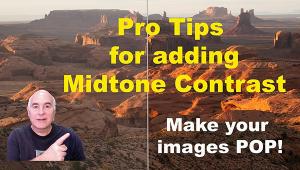The Megapixel Madness Continues
by George Schaub
The recent surge on megapixel counts in all levels of digital cameras, from modest point and shoot all the way through advanced amateur and especially in pro cameras and backs, has users questioning the need for such massive files. Indeed, many have become concerned that their camera is now pushing their computer too hard and that it will actually force them to consider upgrading their laptop or desktop unit—a classic case of the size of the horse determining how large a cart you need to drive. Some photographers claim that 8 or perhaps 10 megapixels is all they really can use, unless they are prepared to step up from their 13x19-inch to a larger printer, upgrade their storage and backup system and get a faster and more powerful computer. In short, many photographers are beginning to question whether these ever-increasing megapixel cameras are overkill.
Manufacturers have pushed the megapixel race so far that most amateurs and enthusiasts will be hard pressed to find anything under 10 megapixels out there. They have crammed so many photo sites on small chips that it is now to the point where the image processor is more important than the lens on the camera. Indeed, in the massive megapixel camera realm, there is talk that the optics we have now will not be able to deliver the resolution goods for these high-res sensors, and we will have to either develop an entirely new class of lenses or turn over a good deal of the optical work to image processors.
Part of what spurred this commentary were your responses to a recent Vote question in this Newsletter. Wrote one reader, “Most people, like myself, do not need a file of 70MB since we are not able to keep up with all the additional equipment required for this type of files. Now we are going to need 5TB hard drives to store and work on this stuff! I am in photography to enjoy it and not to support an industry. If I am lucky enough to sell a few photos great, but lets draw the line somewhere on this technological war between camera manufacturers.”
The infrastructure issue was pointed out in succinct manner by another reader email: “Larger file sizes impact the workflow, computer and network hardware and time devoted to post processing. Time and hardware/network resources for file management and backup will be two to four times greater. A gigabyte network is not out of the question for moving files of this size. But then the hard drive access and write times will be a bottleneck unless increased dramatically. These are not investments many photographers will want to make on top of the camera and lenses.” In other words, large megapixel cameras are making the present computers, image processing software and storage devices now used by photographers obsolete, and are beginning to force buying decisions that must choose between an extra lens or two and a new computer or storage system.
This “tech fatigue” was the point of another note; “I'm not really awaiting further developments. I'm tired of the ever-increasing computer requirements. Upgrading a camera means upgrading my PC too. I'd prefer more bit depth, better high ISO quality and around 10-11megapixel. The files sizes are too large for the huge quantities involved.”
Like the plant in the “Little Shop of Horrors”, the marketing momentum has the latest cameras saying “Feed me, feed me!” but the food here is more megapixels, and the manufacturers don’t seem to know how to keep the ever-growing and voracious omnivore under control. I am not sure if all this means that the photo industry has to become more selective in terms of what its devices deliver, and how they deliver it. I leave that to greater minds than my own. But I do think that the process of jamming ever more megapixels into cameras is something that has to be rethought. It’s like those car ads showing folks taking high horsepower vehicles on mountainous roads they have all to themselves and describing the thrill of the open road, when most folks who actually use a car for work rarely get over 40 MPH. There’s the thrill of making poster size images and the reality of rarely making more than 8x10 prints. Super megapixel cameras sound great, but do most of us really need such giant file sizes?
- Log in or register to post comments












































